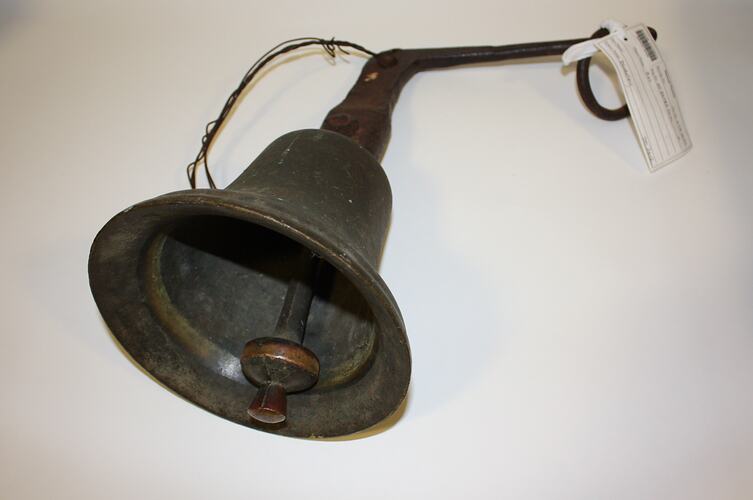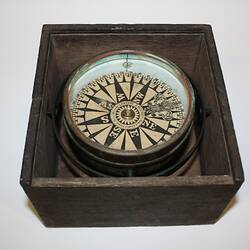Summary
Brass bell with fixed right-angle pivot arm for ringing. The bell would have been suspended by a pivot at the point where the arm bends 90 degrees from vertical to horizonrtal and would have been rung by a bell pull cord attached to a ring on the outer end of the arm.
According to the donor the bell came from the 'Cygnet', a wooden schooner built in 1846 and owned by William Blakeley. It sank on 31 August 1876 in Port Phillip Bay in a northerly gale. It is said that the master was drunk, which precluded an insurance payout on the wreck. It was later advertised for salvage. A second schooner, the 'Fear Not,' is also linked to William Blakeley. It was wrecked in 1882.
A ship's bell is used to indicate the time on board a ship, thus regulating a sailor's duty watch. The bell was also used to sound a warning for other vessels during times of fog or low visibility; in the event of an emergency, such as a fire; or for various shipboard events. Ships' bells are usually made from bronze or brass and often have the ship's name engraved on them. (This bell, however, has no inscription.) Traditionally the ship's bell is maintained by the ship's cook.
According to the donor, after the bell was salvaged from the wreck of the 'Cygnet' it was hung in an oak tree at the family farm 'Ecclesall' at Red Hill to signal mealtimes. The whole neighbourhood knew when the family was going to eat! Orchardists working on the farm were also summoned for refreshments with the bell. In recent years the Blakeley sisters still used the bell for similar reasons.
Part of a collection of and other material relating to the life of William Henry Blakeley and the Blakeley family donated to Museum Victoria. William Blakeley was the first saw manufacturer in Australia. He was born in England in 1839 and was indentured as a saw maker. In 1867 he set up his own saw shop in Little Bourke Street - soon to become a successful manufacturing business, W.H. Blakeley and Co (which became W.H. and Company Proprietary Limited in 1922), with several locations in inner Melbourne. The Blakeley business has continued into the 21st century.
Physical Description
6-inch brass bell with angled iron (or similar metal) arm extending from the crown. Hole at the bend of the arm with wire rope (now frayed) threaded through. Another hole at the far end bears a metal ring. The bell's clapper is a flattened circle with a small tapered extension below.
More Information
-
Collecting Areas
-
Acquisition Information
Donation from Helen Blakeley, 23 Aug 2012
-
Original Owner
-
Other Association (See Comments)
Cygnet, Australia, 1846-1876
Ship on which bell was said to have been used. -
Classification
-
Category
-
Discipline
-
Type of item
-
Overall Dimensions
160 mm (Height), 196 mm (Outside Diameter)
-
Other Dimensions
189 mm (Height)
Dimension of handle
-
References
'Cygnet,' Wrecksite, at: [Link 1] accessed: January 23, 2013 'Cygnet,' Victorian Heritage Database, at: [Link 2] accessed: January 23, 2013 'Fear Not,' Australian National Shipwreck Database, at: [Link 3] accessed: February 13, 2013 'Ships' Bells,' Naval History and Heritage Command, at: [Link 4] accessed: January 30, 2013 John Anthony Leckey, 'Low, Degraded Broots? Industry and entrepreneurialism in Melbourne's Little Lon, 1860-1950,' PhD Thesis for the Department of History, University of Melbourne, April 2003
[Book] Blakeley, Helen. 2016. W.H. Blakeley: Pioneer Saw Maker, Farmer & Trade Unionist.
-
Keywords
Ship's Bells, Ships, Ship Accessories, Warning Systems, Navigation, Water Transport, Orchards


